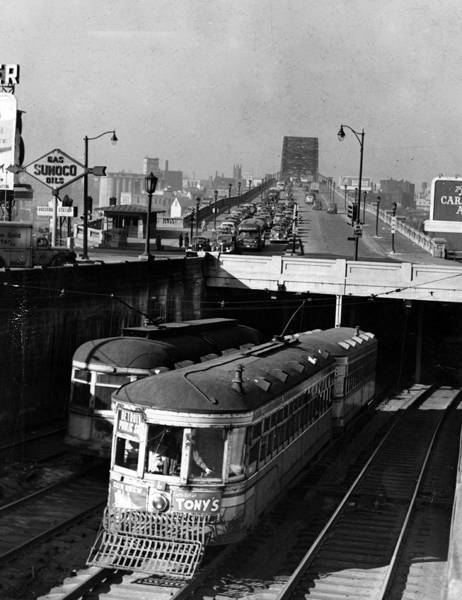CLEVELAND — The next time the Lake Erie wind or bitter cold gets the best of Cleveland's pedestrians, it may prompt a reminder that the city once seriously considered adding a heavy-rail, underground subway system downtown in the 1950's.
"I don’t think anyone knows this was on the table," said Cleveland State history professor Mark Souther. "We came pretty close to getting a subway in the 1950s."
Souther spent more than a year sifting through articles and transcripts, uncovering how voters said yes, but county leaders said no.
"The county engineer, Alfred Porter, was vociferously against anything having to do with rail," Souther said. "He was a freeway man and saw that as the future."
In 1953, two-thirds of Cuyahoga County voters approved a $35 million bond issue for a downtown, underground circulator subway.
The prominent version presented involved a half-mile square loop connecting what's now Tower City with Playhouse Square and Halle's, plus the financial hub and what we now know as The 9 and county offices at Huron Road and East 9th Street.

"You had to distribute riders around downtown," Souther explained. "I’m not sure the subway plan in and of itself would have created a Chicago Loop scenario, but I do think it would have made some difference."
Cuyahoga County still has RTA Rapid Transit to bring people to Cleveland, but this plan would spread them around downtown and out of the elements.
It would have also completed the last mile for Cleveland’s commuters and shoppers during the city’s heyday.

"This was a time when people were crowding in downtown and complaining of congestion," Souther said.
Hearings, studies and different route options continued to pop up throughout the 50s. By the end, about 12 different subway variations had been presented.

If Downtown Cleveland Alliance President and CEO Michael Deemer had a magic wand, he told News 5 he would go back in time and push through the project.
"We made a decision as a community to go in a very different direction, and in a lot of ways, I think we’re still dealing with the consequences of those decisions," he said.
However, by the end of the decade, the signed-off idea faded away as freeway growth took center stage and development extended into the suburbs — Something Souther and Deemer will always wonder “what if.”
"The idealist in me thinks this was truly a missed opportunity," Souther explained. "It certainly would have made for a different experience that might have made people come downtown more often and not just go to their suburban mall, but the pragmatic me knows the cost overrun was a distinct possibility and probably a likely scenario."
"The immediately surrounding area and city would have grown up and evolved as a more dense walkable place, kind of like the one we want to create today," Deemer said.
Wait — didn't Cleveland have a subway system of sorts back then?
Not exactly.
When people think of a Cleveland subway, they usually think of underneath the Detroit-Superior bridge, which once housed street cars. Those were light rail, whereas the downtown Cleveland subway plan involved heavy rail, which can carry more weight and is similar to what you see in other major metropolitan cities such as New York and Washington D.C.
Just two weeks ago, News 5 reported about plans to convert the streetcar corridor of the Detroit-Superior Bridge, known as the Veterans Memorial Bridge, into a park for people to enjoy, similar to New York City's High Line.
"I think this is all about connecting a new economy," Cuyahoga County Executive Chris Ronayne said.
So what's next for Northeast Ohio and transportation?
From atop the abandoned streetcar corridor of the Detroit-Superior bridge, newly-elected Cuyahoga County Executive Chris Ronayne took our “what if” and answered “what next,” as he outlined how he hopes to mirror the transportation growth he oversaw with University Circle.
RELATED: Which zip code in Cuyahoga County saw the largest increase in jobs over the last 15 years?
"Our population grew as the HealthLine advanced and the Red Line stations opened up," Ronayne explained. "I think Cleveland is going to play a bit of catch up but Cleveland and Cuyahoga County is going to see good things happen in transportation."
Data from the U.S. Census shows Northeast Ohio takes the top spots in the state when it comes to households without access to a car. In East Cleveland, 35% of households do not own a single car, followed by Cleveland with almost one out of every four households without access to a car.
Across Cuyahoga County, that amounts to about 12% of the driver-eligible population without access to a car.
In addition to ground transportation, Ronayne detailed the importance of enabling the next generation of transportation, whether that's autonomous vehicles or smaller aircraft capable of landing just about anywhere.
RELATED: How Cleveland plays a role in mapping out a new sky highway for drones, autonomous aircraft and more

"I think here for the future – we’re faced with a hybrid of transportation modes," Ronayne said. "I think people are going to be moving about in ways we almost cannot predict."
Clay LePard is a special projects reporter at News 5 Cleveland. Follow him on Twitter @ClayLePard or on Facebook Clay LePard News 5.
Download the News 5 Cleveland app now for more stories from us, plus alerts on major news, the latest weather forecast, traffic information and much more. Download now on your Apple device here, and your Android device here.
You can also catch News 5 Cleveland on Roku, Apple TV, Amazon Fire TV, YouTube TV, DIRECTV NOW, Hulu Live and more. We're also on Amazon Alexa devices. Learn more about our streaming options here.





